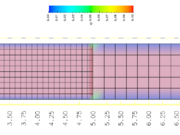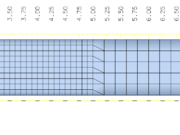Difference between revisions of "HowTo Import a fluent mesh with interfaces"
m |
m |
||
| Line 7: | Line 7: | ||
To convert such a mesh, just use fluentMeshToFoam utility. Let consider the current [[Media:test_interface.tgz|case]], where an "inlet", an "outlet" and two interface "interface_coarse" and "interface_fine" boundaries are defined. The rest of the boundaries are considered walls. | To convert such a mesh, just use fluentMeshToFoam utility. Let consider the current [[Media:test_interface.tgz|case]], where an "inlet", an "outlet" and two interface "interface_coarse" and "interface_fine" boundaries are defined. The rest of the boundaries are considered walls. | ||
<div align=center> | <div align=center> | ||
| − | + | fluentMeshToFoam ./ test_interfaces test_interface/geometry/test_interface.msh | |
</div> | </div> | ||
Once imported, the mesh consists of actually two separated volumes, by the interface_fine and interface_coarse surfaces. | Once imported, the mesh consists of actually two separated volumes, by the interface_fine and interface_coarse surfaces. | ||
The second step is to stitch the meshes by spliting the faces of the two interfaces creating polyhedral cells: | The second step is to stitch the meshes by spliting the faces of the two interfaces creating polyhedral cells: | ||
<div align=center> | <div align=center> | ||
| − | + | stitchMesh ./ test_interfaces interface_fine interface_coarse | |
</div> | </div> | ||
Now the mesh looks something like in Figure 2. [[Image:interface_drg1.png|thumbnail|Figure 2 Stiched mesh]] | Now the mesh looks something like in Figure 2. [[Image:interface_drg1.png|thumbnail|Figure 2 Stiched mesh]] | ||
Revision as of 15:33, 15 March 2007
1 Purpose
The purpose of this short HowTo is to explain the few steps that are necessary in order to read a fluent mesh that contains interfaces.
Valid versions: ![]()
2 How is it done
A mesh with an interface is a mesh containing two overlapping surfaces that do not necessary share the same discretization nodes, as seen in Figure 1.To convert such a mesh, just use fluentMeshToFoam utility. Let consider the current case, where an "inlet", an "outlet" and two interface "interface_coarse" and "interface_fine" boundaries are defined. The rest of the boundaries are considered walls.
fluentMeshToFoam ./ test_interfaces test_interface/geometry/test_interface.msh
Once imported, the mesh consists of actually two separated volumes, by the interface_fine and interface_coarse surfaces. The second step is to stitch the meshes by spliting the faces of the two interfaces creating polyhedral cells:
stitchMesh ./ test_interfaces interface_fine interface_coarse
The utility will preserve also the original patches as boundaries, but since they are no longer needed, they can be safely deleted from the polyMesh/boundary file.
3 Download
The sources of the test case can be downloaded from: [test_interfaces]

